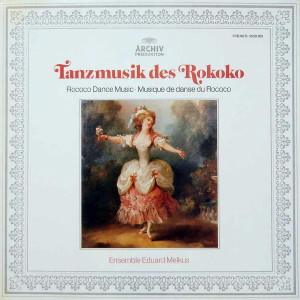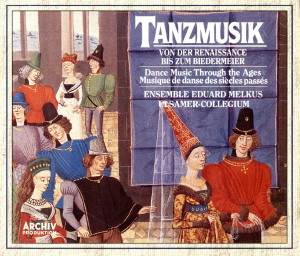 |
|
1 LP -
2533 303 - (p) 1975
|
 |
| 4 CD's -
439 964-2 - (c) 1992 |
|
| TANZMUSIK DES ROKOKO |
|
|
|
|
|
|
|
| Rococo Dance Music |
|
|
|
|
|
|
|
| Carl Philipp Emanuel Bach
(1714-1788) |
5 Polonaisen, Wq
190 |
Ms. Brüssel,
Conservatoire de Musique, V No.
6371 * |
|
|
|
|
- Polonaise |
|
|
1' 12" |
A1 |
|
- Polonaise |
|
|
1' 25" |
A2 |
|
- Polonaise |
|
|
1' 35" |
A3 |
|
- Polonaise |
|
|
1' 15" |
A4 |
|
- Polonaise |
|
|
1' 17" |
A5 |
| Jean-Philippe Rameau
(1683-1764) |
Tänze aus
"Zoroastre" |
Ms. Paris,
Bibliothèque Nationale, VM2 376
(nicht in der Rameau-Ausgabe) |
|
|
|
|
- Air tendre en
Rondeau |
|
|
1' 25" |
A6 |
|
- Loure |
|
|
2' 38" |
A7 |
|
- Tambourin en
Rondeau |
|
|
0' 51" |
A8 |
|
- Sarabande |
|
|
2' 08" |
A9 |
|
- Gavotte gaye
avec Trio |
|
|
1' 23" |
A10 |
|
- Premier Rigaudon
|
|
|
1' 47" |
A11 |
|
- Air en Chaconne |
|
|
5' 24" |
A12 |
| Josef Starzer
(1726-1787) |
Contredanse |
aus "Diane et
Endimione", Ms. Wien,
Gesellschaft der Musikfreunde, Q
18 664 * |
|
1' 03" |
B1 |
| Josef Starzer
|
Gavotte mit Trio |
aus "Roger et
Bradamante", Ms. Wien,
Gesellschaft der Musikfreunde, Q
18 722 * |
|
2' 14" |
B2 |
| Josef Starzer
|
"Pas de deux" |
aus "Diane et
Endimione", Ms. Wien,
Gesellschaft der Musikfreunde, Q
18 664 * |
|
2' 13" |
B3 |
| Josef Starzer
|
Menuett |
aus "Diane et
Endimione", Ms. Wien,
Gesellschaft der Musikfreunde, Q
18 664 * |
|
1' 04" |
B4 |
| Josef Starzer |
Gavotte mit Trio |
aus "Gli Orazi e
gli Curiazi". Ms. Wien,
Osterreichische
Nationalbibliothek, Sm 3868 * |
|
1' 32" |
B5
|
| Josef Starzer |
Moderato |
aus "Roger et
Bradamante", Ms. Wien,
Gesellschaft der Musikfreunde, Q
18 722 * |
|
1' 13" |
B6 |
| Josef Starzer
|
Gavotte |
aus "Diane et
Endimione", Ms. Wien,
Gesellschaft der Musikfreunde, Q
18 664 * |
|
1' 13" |
B7 |
| Josef Starzer
|
Menuett mit Trio |
aus "Diane et
Endimione", Ms. Wien,
Gesellschaft der Musikfreunde, Q
18 664 * |
|
3' 13" |
B8 |
| Josef Starzer |
Gavotte mit Trio
|
aus "Roger et
Bradamante", Ms. Wien,
Gesellschaft der Musikfreunde, Q
18 722 * |
|
2' 39" |
B9 |
| Josef Starzer |
Passepied mit
Trio |
aus "Roger et
Bradamante", Ms. Wien,
Gesellschaft der Musikfreunde, Q
18 722 * |
|
1' 51" |
B10 |
| Carl Philipp Emanuel
Bach |
Dances, Wq 189 |
Ms. Brüssel,
Conservatoire de Musique, V No.
6371 * |
|
|
|
|
- Menuett mit Trio |
|
|
2' 20" |
B11 |
|
- Trio |
|
|
0' 53" |
B12 |
|
- Menuett mit Trio |
|
|
2' 17" |
B13
|
|
|
|
|
* = nicht ediert
|
|
|
|
| ENSEMBLE
EDUARD MELKUS |
| -
Eduard Melkus, Spiros Rantos, Rudi
Kalup, Roberta Elliot, Cynthia
Rames, Violine I |
| -
Michael Stüve, Mikis Michaelidis,
Clemens Hellsberg, Alexander Krins,
Violine II |
| -
Lilo Gabriel, James Thornton, Viola |
| -
Walter Schulz, Carolyn Hopkins, Violoncello |
| -
Gerald Sonneck, Violone |
| -
Sebastian Kelber, Gottfried Hechtl,
Traverflöte |
| -
Helmut Hucke, Christian Lange, Oboe,
Engl. Horn |
| -
Wolfgang Rühm, Gerhard Totzauer, Klarinette |
| -
Friedrich Gabler, Gregor Widholm, Horn |
| -
Walter Stiftner, Fagott |
| -
Wolfgang Gabriel, Cembalo |
|
|
|
|
Luogo
e data di registrazione |
|
Palais
Schönburg, Vienna (Austria) - 4-7
febbraio 1975 |
|
|
Registrazione:
live / studio |
|
studio |
|
|
Production |
|
Dr.
Andreas Holschneider |
|
|
Recording
supervision |
|
Franz-Christian
Wulff |
|
|
Recording Engineer |
|
Klaus
Scheibe |
|
|
Prima Edizione LP |
|
ARCHIV
- 2533 303 - (1 LP - durata 47'
04") - (p) 1975 - Analogico |
|
|
Prima Edizione CD |
|
ARCHIV
- 439 964-2 - (4 CD's - durata 71'
35"; 70' 09"; 70' 42" & 72'
56" - [CD3 1-25]) - (c) 1992 - ADD
|
|
|
Cover |
|
Jean-Honoré
Fragonard "Danseuse" (Tänzerin · A
Dancer) - Photo: Three Lions, New
York |
|
|
Note |
|
-
|
|
|
|
|
Rococo Dance
Music
Rococo (from the French rocaille)
is a term used for the style
characteristic of the arts as
cultivated during the second
half of the 18th century - a
more graceful, and delicately
ornate offspring of the Baroque,
which accompanied the last
glories ofthe Ancien Regime.
Thus the rococo age was that of
Louis XV and XVI in France, and
in Germany and Austria that of
Frederick the Great and the
Empress Maria Theresa. The
rococo attitude to life was
mirrored in the elegant and
superficial graces of courtiers,
and in the “back to nature”
movement initiated by Rousseau
but never taken very seriously,
leading as it did to little more
than highly artificial pastoral
entertainments and picnics. In
Germany, however, this was also
the Age of Enlightenment, which
brought about the first major
steps toward a genuinely natural
way of life and view of the
world. All this was reflected
both in literature and in music.
In the realm of music it is not
easy to highlight the rococo
style as distinct from that of
the late Baroque and early
Classical periods. Dance music
of this era almost automatically
is at home in courtly
surroundings, and it is closely
connected with the stage, with
stage dancing and ballet. The
dances chosen for this recording
are from three great centres of
rococo art: the France of Louis
XV the Vienna of the Empress
Maria Theresa, and Germany,
where musical life flourished
both in the princely residences
and in Free and Imperial cities.
Jean-Philippe Rameau lived in
Paris from 1722 until his death.
He was a major composer of
operas and ballets, which were
produced under the patronage of
the wealthy tax collector A.J.
Le Riche de La Pouplinière.
Dances figure prominently not
only in Rameau’s opera-ballets,
but also in his other stage
works. This is the case in the tragédie
lyrique Zoroastre, which
was first performed on 5
December 1749 and was revived in
a new version in January 1756.
The score of this work, in its
original version, was published
in Paris around 1750. The dance
forms used in it are those of
dances popular in society at
that time.
The Viennese composer Josef
Starzer wrote much ballet music.
Trained as a violinist, singer
and composer, he joined the
orchestra of the French Theatre
at Vienna in 1752, and there he
was appointed by Count Durazzo,
the Imperial Theatre Director
and patron of Gluck, as
“Compositeur des Airs pour les
ballets”. The musical historian
Dr. Burney praised him as a
violinist, writing that he
“executes Adagios with uncommon
inwardness and feeling”, Starzer
won fame through his
collaboration with the ballet
dancer and choreographer
Noverre, an association which
gave rise to numerous works
including those from which the
dances in this recording are
taken: Diane et Endimione,
1771/72, Roger et Bradamante,
1771, and Gli Orazi e gli
Curiazi, 1774.
Carl Philipp Emanuel Bach was
the second surviving son of
Johann Sebastian Bach. From 1738
onwards he was active as one of
Frederick the Great’s chamber
musicians, and was appointed
harpsichordist at the Berlin
court in 1741, following
Frederick’s accession to the
throne. He was not, however,
altogether happy in the service
of the king, whose musical taste
was exclusively French, and
several times he applied for
other posts, until in 1767 he
succeeded his god-father
Telemann as municipal musical
director in Hamburg, in which
capacity he was responsible for
the musical performances at the
five principal churches in
Hamburg, He died there in 1788.
The Polonaises and Minuets
included here were probably
composed for a splendid ball; as
they cannot be dated it is not
known whether they were written
for the Berlin court or for
Hamburg. Possibly it was the
example of Telemann, in whose
works Polish elements feature
prominently, or perhaps the
links between the Prussian court
and Eastern Europe, which led to
the composition of these
Polonaises as music for a
society function.
We are deeply grateful to the
directors of the musical
institutions who have made the
necessary material available to
us, and especially to the
custodian of the musical
collection at the Austrian
National Library, Hofrat Dr.
Grasberger, in whose premises we
were allowed to play Starzer’s
dances from the original
manuscripts, to select the most
valuable among them.
In this recording we placed
great importance on using only
original instruments, including
wind instruments. Some
particularly attractive touches
of original instrumentation are
worth mentioning, e.g. the use
of English horns, with pizzicato
strings, in Starzer’s Gavotte in
B flat, and the clarinet parts
which C.P. E. Bach still wrote
entirely in the style of the
“clarino”. Very typical of this
composer, even in these little
pieces, is the instrumentation
with high and expressive flutes,
quite different from the gentle
doubling of the flutes in
Starzer’s Minuets, which points
to the influence of johann
Christian Bach. Especially
interesting is Starzer’s slow
movement with solo oboe and
viola - a true pas de deux
even in the choice of solo
instruments. Rameau’s scoring is
also full of surprises, such as
the solo horn in the Loure.
We have been able to try out all
these dances in conjunction with
dancers who, under the direction
of my colleague at the Vienna
Musikhochschule Eva Campianu,
have specialized in historical
dance steps. This gave us
valuable assistance in choosing
the tempi.
Eduard
Melkus
(Translation:
John Coombs)
|
|
|

